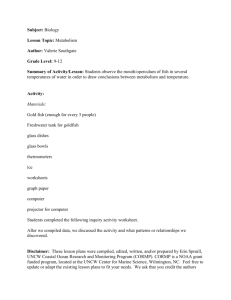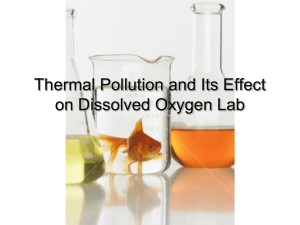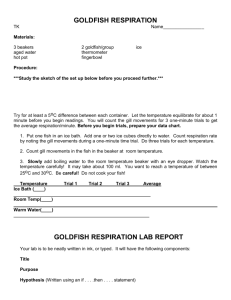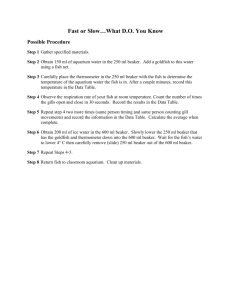How Water Temperature Affects Goldfish Operculum
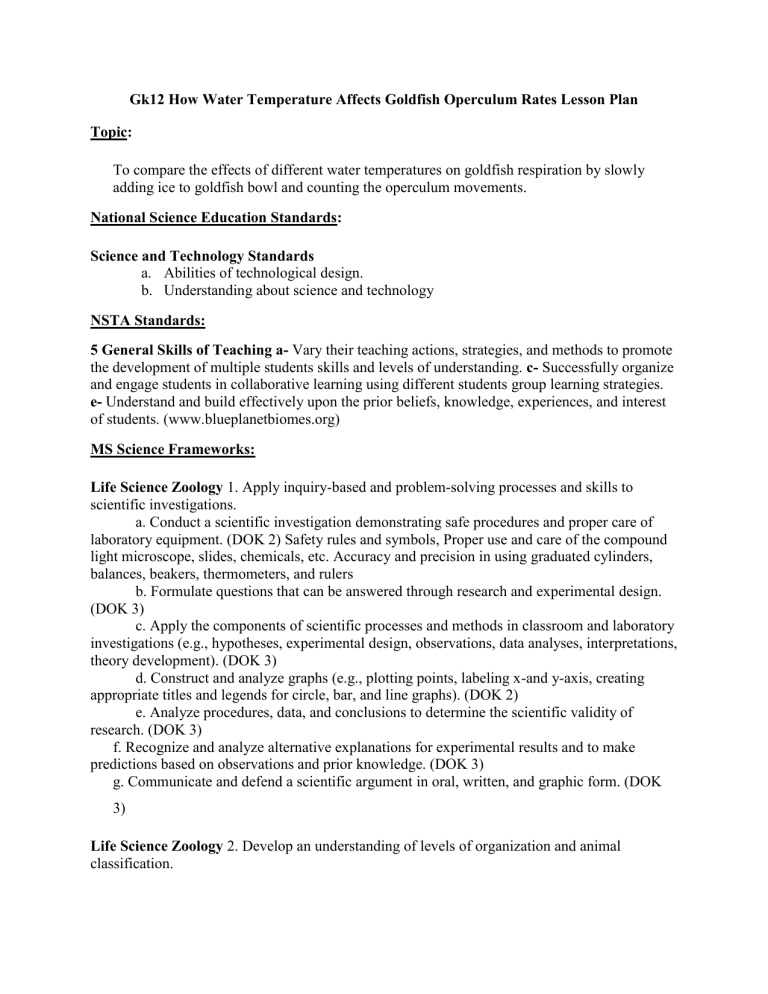
Gk12 How Water Temperature Affects Goldfish Operculum Rates Lesson Plan
Topic:
To compare the effects of different water temperatures on goldfish respiration by slowly adding ice to goldfish bowl and counting the operculum movements.
National Science Education Standards:
Science and Technology Standards a.
Abilities of technological design. b.
Understanding about science and technology
NSTA Standards:
5 General Skills of Teaching a Vary their teaching actions, strategies, and methods to promote the development of multiple students skills and levels of understanding. c Successfully organize and engage students in collaborative learning using different students group learning strategies. e Understand and build effectively upon the prior beliefs, knowledge, experiences, and interest of students. (www.blueplanetbiomes.org)
MS Science Frameworks:
Life Science Zoology 1. Apply inquiry-based and problem-solving processes and skills to scientific investigations.
a. Conduct a scientific investigation demonstrating safe procedures and proper care of laboratory equipment. (DOK 2) Safety rules and symbols, Proper use and care of the compound light microscope, slides, chemicals, etc. Accuracy and precision in using graduated cylinders, balances, beakers, thermometers, and rulers b. Formulate questions that can be answered through research and experimental design.
(DOK 3) c. Apply the components of scientific processes and methods in classroom and laboratory investigations (e.g., hypotheses, experimental design, observations, data analyses, interpretations, theory development). (DOK 3) d. Construct and analyze graphs (e.g., plotting points, labeling x-and y-axis, creating appropriate titles and legends for circle, bar, and line graphs). (DOK 2) e. Analyze procedures, data, and conclusions to determine the scientific validity of research. (DOK 3) f. Recognize and analyze alternative explanations for experimental results and to make predictions based on observations and prior knowledge. (DOK 3) g. Communicate and defend a scientific argument in oral, written, and graphic form. (DOK
3)
Life Science Zoology 2. Develop an understanding of levels of organization and animal classification.
a. Explain how organisms are classified and identify characteristics of major groups.
(DOK 1) Levels of organization of structures in animals (e.g., cells, tissues, organs, and systems) structure, biochemistry, anatomy, fossil record, and methods of reproduction) b. Identify and describe characteristics of the major phyla. (DOK 1) Symmetry and body plan, Germ layers and embryonic development, Organ systems (e.g., digestive, circulatory, excretory, and reproductive), Locomotion and coordination d. Differentiate among the characteristics of Bacteria, Archaea, and Eucarya. (DOK 1)
Phylogenic sequencing of the major phyla, Invertebrate characteristics (e.g., habitat, reproduction, body plan, locomotion) of the following phyla: Porifera, Cnidarians,
Nematoda, Annelida, Platyhelmenthes, Arthropoda (Insecta, Crustacea, Arachnida, Mollusca
[Bivalvia and Gastropoda], and Echinodermata), Vertebrate characteristics (e.g., habitat, reproduction, body plan, locomotion) of the following classes: Agnatha, Chondrichthyes,
Osteichthyes, Amphibia, Reptilia, Aves, and Mammalia
Life Sciences Zoology 3. Differentiate among animal life cycles, behaviors, adaptations, and relationships. a. Describe life cycles, alternation of generations, and metamorphosis of various animals and evaluate the advantages and disadvantages of asexual and sexual reproduction. (DOK 1) b. Describe and explain concepts of animal behavior and differentiate between learned and innate behavior. (DOK 1) Division of labor within a group of animals, Communication within animals groups, Degree of parental care given in animal groups c. Evaluate the unique protective adaptations of animals as they relate to survival. (DOK
2) d. Compare and contrast ecological relationships and make predictions about the survival of populations under given circumstances. (DOK 3) Terrestrial and aquatic ecosystems,
Herbivores, carnivores, omnivores, decomposers and other feeding relationships Symbiotic relationships such as mutualism, commensalisms, and parasitism
Earth and Space Science Marine Biology 2.
Develop an understanding of physical and chemical properties of water and aquatic environments.
a. Analyze the physical and chemical properties of water and justify why it is essential to living organisms. (DOK 1) d. Compare and contrast the physical and chemical parameters of dissolved O2, pH, temperature, salinity, and results obtained through analysis of different water column depths/zones. (DOK 2)
Objectives:
Students will utilize lab safety techniques.
Students will use the scientific method to predict the results of the experiment.
Students will learn about how goldfish breathe in water.
Students will observe the effects of temperature change on goldfish breathing.
Students will learn how to properly handle and treat live laboratory specimens.
Classroom Procedure:
Engage
First, ask the students to observe the fish in the classroom fish tank and discuss environmental factors that affect the fish. Second, ask the students if they have bought a fish from the pet store, what care instructions came with the fish, and why they thought it was necessary to “float” the fish in its bag before letting it out into the fish tank.
Materials:
Classroom fish tank with fish (optional)
Time: 10 min
Classroom arrangement: students can remain in their assigned classroom seats
Explore
Have students go to the lab and conduct and experiment to determine a goldfish’s breathing rate at room temperature by counting the number of operculum movements per minute and averaging the counts over at least 3 trials (this will be the control). Next, have the students determine a goldfish’s breathing rate as the water temperature is decreased in 2°C intervals by adding ice to the water.
Materials:
Goldfish (the cheap kind will do)
500 ml beaker of tap water
250 ml beaker of ice
Glass stir rod
Thermometer
Timer
Lab worksheet
Time: 15 min
Classroom arrangement: students will work in pairs with one goldfish per pair
Explain
Discuss how fish utilize their gills to extract oxygen from their environment, explain what the operculum is and how it works, and clarify how the opening and closing of the operculum can be used to determine the fish’s breathing rate.
Materials: Lab worksheet
Time: 5 min
Classroom arrangement: students can either be with their lab partners or in their assigned classroom seats
Elaborate
Have students go to the lab and conduct and experiment to determine a goldfish’s breathing rate as the water temperature is increased in 2°C intervals by adding drops of 50-60°C water and
counting the number of operculum movements per minute and averaging the counts over at least
3 trials.
Materials:
Goldfish (the cheap kind will do)
500 ml beaker of tap water
250 ml beaker of 50-60°C water
Glass stir rod
Thermometer
Timer
Lab worksheet
Transfer pipette
Time: 1 hr
Classroom arrangement: students will work in pairs with one goldfish per pair
Evaluate
Students will answer the lab questions and discuss the answers as a class. Students will turn in completed activity sheet. To be more interactive, students will discuss their answers with each other before turning in their activity sheet.
Materials: Lab worksheet
Time: 5 min
Classroom arrangement: students can either be with their lab partners or in their assigned classroom seats
Note: This lab can be repeated to test for the affects increasing the water temperature has on goldfish breathing by adding a transfer pipette full of warm water to the beaker instead of ice.
References:
1.
“How does temperature affect respiration rates of fish?” http://web.nestucca.k12.or.us/tec/aquatic-freshwater/Science/Water%20Quality/Activity-
%20Temperature%20vs%20Fish%20Respiration.pdf
<3 April 2013>.
Name:_________________________________ Date:___________________
How Water Temperature Affects Goldfish Operculum Rates
Objective:
To examine the effect of temperature on the breathing rate of fish.
To correlate the structural mechanisms found in fish with their ability to function in a changing habitat.
Introduction:
Different organisms have specialized structures to accomplish the task of removing oxygen from their environment and transporting it to the cell. The oxygen is ultimately used in the oxidation of foods and in other metabolic activities. This utilization of oxygen is called respiration. This involves removing oxygen from the external environment and trapping it inside the organism’s body. Internal respiration refers to the cellular phase, which actually utilizes the oxygen to break down food products to release energy needed by the organism. Carbon dioxide and water are also products of respiration and constitute a necessity for removal of an extra accumulation of either product. Usually this is accomplished by a reversal of the method of bringing in the supply of oxygen.
Many of the marine animals breathe by means of gills. In vertebrates, gills are made up of gill filaments found beneath the operculum (Figure 1). The operculum can be thought of as a gill cover. Since it is difficult to extract the available oxygen from an aquatic environment, the gill has to be constructed for high efficiency. The gill filament has a very large surface area and this allows for maximum exposure to the water environment.
When the fish breathes, it opens its mouth and the operculum closes. It then closes its mouth and contracts the pharynx, which forces the water across the gill filaments. As water passes over the delicate filaments, excess oxygen diffuses into the capillary circulatory network and is distributed throughout the fish’s body. The excess carbon dioxide also diffuses from the capillary network into the surrounding water. When the pharynx contracts, this forces the operculum open and completes the circuit for the water to flow. The water passes out of the operculum and another breathing cycle is ready to begin. The opening and closing of the operculum can be used to determine the breathing rate of a fish.
Hypothesis:
How do you think that a decrease in the water temperature will affect the breathing rate?
______________________________________________________________________________
______________________________________________________________________________
Figure 1: The operculum is the flap that covers the gills.
Materials:
500 ml beaker of Tap water
250 ml beaker of ice
1 L beaker of 50-60°C water
Goldfish
Glass stirring rod
Thermometer
Aquarium net
Transfer pipette
Lab worksheet
Procedure:
1.
PART 1: Place one goldfish in 500 ml beaker with enough tap water so the fish can swim around.
2.
Measure the temperature of the water (should be approximately room temperature or
25°C), and wait a few minutes to allow the fish to adjust to the shock of being placed in its new environment.
3.
Set the timer for one minute and begin counting the operculum movements. Repeat this step two more times.
4.
Record the data in Table 1.
5.
Slowly add ice one cube at a time (crushed ice works better than cubed) until the temperature drops by two degrees.
6.
Stir the water with the ice in it with the glass rod (do not let the students stir with the thermometers as they are delicate). Stir gently so as not to disturb the fish. Note: this would be a good time to lecture your students on proper care of live specimens.
7.
Set the timer for one minute and begin counting the operculum movements. Repeat this step two more times.
8.
Record the data in Table 1.
9.
Repeat steps 5-8 until the data chart is complete or the water has dropped no more than
10°C. We do not want to kill the fish!
10.
At the conclusion of part one of the experiment, gradually add warm water to bring the fish back up to an appropriate temperature (20-25°C). Place this fish aside and get a new fish.
11.
PART 2: Next, we will repeat the lab only this time increase the temperature of the fish’s water by adding a 3 ml transfer pipette full of 50-60°C water to increase the water temperature by 2°C intervals.
12.
Measure the temperature of the new fish’s water (should be approximately room temperature or 25°C), and wait a few minutes to allow the fish to adjust to the shock of being placed in its new environment.
13.
Set the timer for one minute and begin counting the operculum movements. Repeat this step two more times.
14.
Record the data in the Table 2.
15.
Slowly add a 3 ml transfer pipette full of 50-60°C water until the fish’s water increases by two degrees.
16.
Stir the water with the glass rod and let the fish acclimate for a minute or two.
17.
Set the timer for one minute and begin counting the operculum movements. Repeat this step two more times.
18.
Record the data in Table 2.
19.
Repeat steps 15-18 until the data chart is complete or the water has increased no more than 10°C. We do not want to kill the fish!
20.
At the conclusion of part two of the experiment, gradually add ice to the water to bring the fish back down to an appropriate temperature (20-25°C).
21.
Have the students graph, discuss, and compare their data to other groups.
Data:
Trial
1
Table 1: Operculum Beats per Minute as Temperature Decreases
25°C 23°C 20°C 18°C 15°C
2
3
Average
Operculum Beats per Minute vs. Decrease in Temperature
Operculum Beats per Minute
Table 2: Operculum Beats per Minute as Temperature Increases
Trial
1
2
3
Average
25°C 27°C 30°C 32°C 35°C
Operculum Beats per Minute vs. Increase in Temperature
Operculum Beats per Minute
Discussion:
1.
What effect did a decrease in temperature seem to have on the respiratory rate of the fish?
______________________________________________________________________________
______________________________________________________________________________
2.
Why was time allotted between temperature changes and operculum observations?
______________________________________________________________________________
______________________________________________________________________________
3.
How did your individual data compare with other groups in the class? a.
Explain___________________________________________________________
______________________________________________________________________________
______________________________________________________________________________ b.
Why do scientists examine group data?__________________________________
______________________________________________________________________________
______________________________________________________________________________
4.
Do you think that all animals would be affected in this manner by temperature changes?
Explain._________________________________________________________________
______________________________________________________________________________
______________________________________________________________________________
